Nepal is home to a wide variety of birds, from the majestic Himalayan griffon vulture to the colorful Indian roller. With over 850 species of birds found in the country, Nepal is one of the most important birding destinations in the world.
The country is also home to some of the most endangered species of birds in the world, including the critically endangered Bengal florican and the endangered Lesser Florican.
We will take a look at some of the most interesting Nepal birds and their unique characteristics.
1. Himalayan Monal
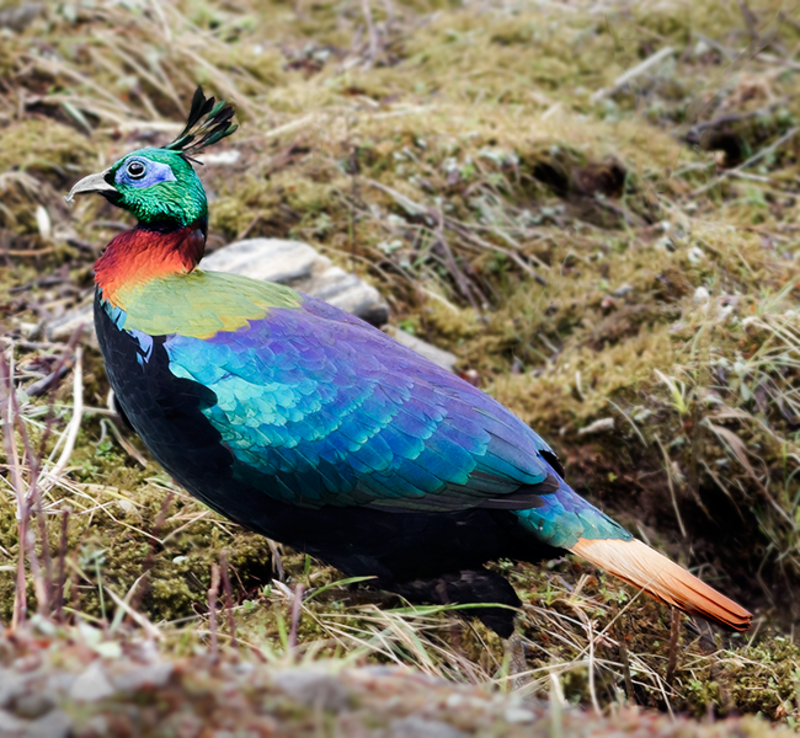
The Himalayan monal (Lophophorus impejanus) is a beautiful species of pheasant native to the forests and shrublands of the Himalayas. It can be found at elevations ranging from 2,100-4,500 meters.
This magnificent creature has been listed as Least Concern on IUCN’s Red List due to its wide distribution range and stable population size.
In Nepal it is known as Danphe or Danfe, which also happens to be their national bird.
Uttarakhand in India recognizes this species as their state bird too. The colorful feathers boast hues of green, blue and bronze that make them quite captivating to watch out for.
Scientific classification:
| Kingdom | Animalia |
| Phylum | Chordata |
| Class | Aves |
| Order | Galliformes |
| Family | Phasianidae |
| Genus | Lophophorus |
| Species | L. impejanus |
2. Spiny Babbler
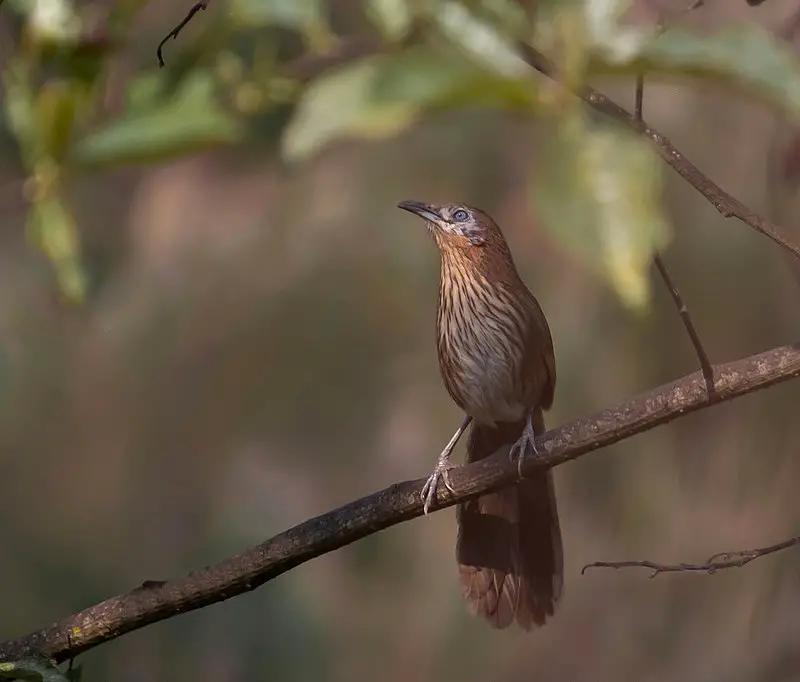
The Spiny Babbler (Turdoides nipalensis) is an exotic species of bird found only in the Middle Hills region of Nepal. Commonly known as Kande Bhyakur, meaning “thorny bird” this small passerine resides around the Kathmandu valley near Godavari and Phulchoki area close to Lalitpur.
It has a dark-brown body with white patches on wings and tail; its backside is spiky due to long feathers giving it unique look among other birds. Its diet consists mainly of insects such as beetles, spiders, crickets etc., but also eat fruits from time to time like berries or wild apples.
The Spiny Babblers are monogamous pair living together for many years until one dies off after which they find new partner again for mating season.
Scientific classification:
| Kingdom | Animalia |
| Phylum | Chordata |
| Class | Aves |
| Order | Passeriformes |
| Family | Leiothrichidae |
| Genus | Turdoides |
| Species | T. nipalensis |
3. Satyr Tragopan
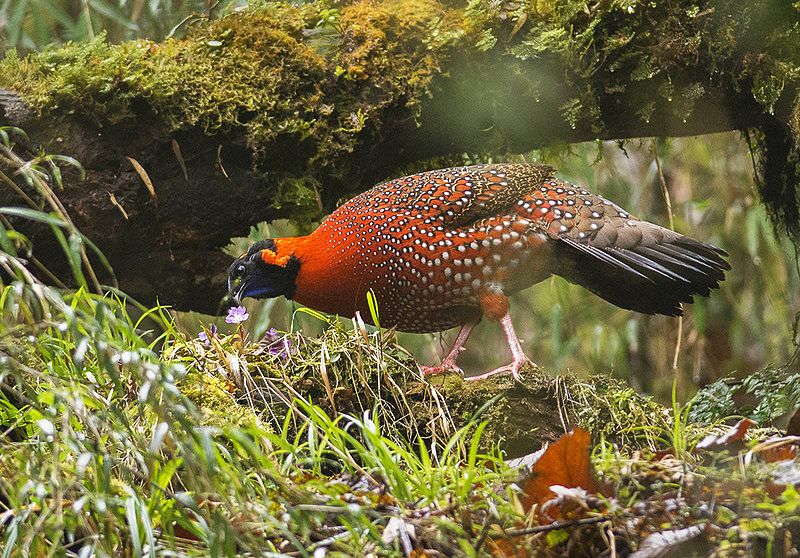
The Satyr tragopan is a majestic bird found in the Himalayan region of India, Tibet, Nepal and Bhutan.
It inhabits moist oak and rhododendron forests with dense undergrowth and bamboo clumps at altitudes ranging from 2400 to 4200 meters during summer months and 1800 meters during winter.
The male measures around 70 cm long. During mating season, males become even more striking as they display their beautiful crimson-colored horns atop their head while fanning out an impressive tail adorned with blue spots.
These birds are omnivorous but primarily feed on berries, fruits seeds plants shoots along with small insects like ants & beetles for added nutrition.
Its unique plumage makes it distinctive among other pheasants species making them popular targets for hunters who seek its feathers as trophies or decorative items .
Scientific classification:
| Kingdom | Animalia |
| Phylum | Chordata |
| Class | Aves |
| Order | Galliformes |
| Family | Phasianidae |
| Genus | Tragopan |
| Species | T. satyra |
4. Monal
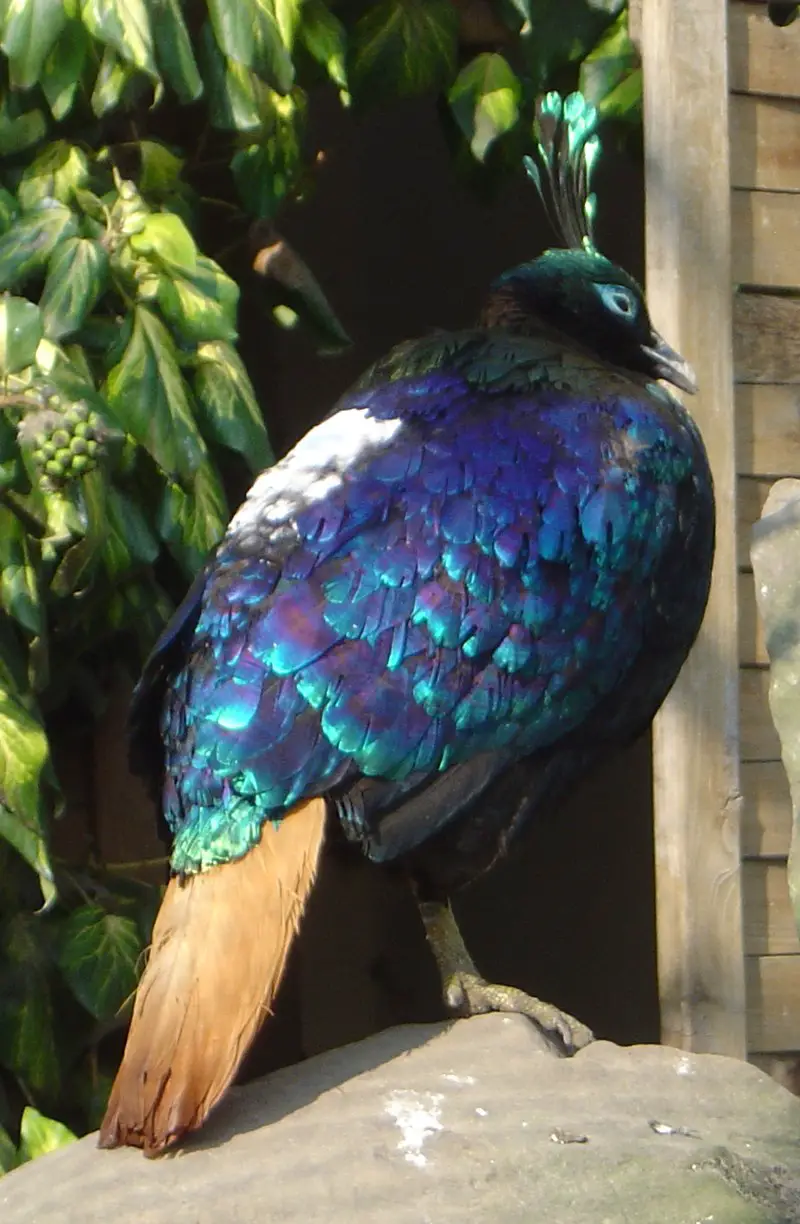
Monal is a bird belonging to genus Lophophorus of the pheasant family, Phasianidae. The male Monals have colorful and iridescent plumage which makes them attractive.
They are plump in shape with their diet consisting mostly of plants such as roots and bulbs along with some insects thrown in for good measure.
During mating season, the males become polygamous by taking multiple partners while females only stick to one partner forming monogamous relationships.
Overall it can be said that Monal birds make an interesting sight due to their fascinating characteristics and vibrant colors.
Scientific classification:
| Kingdom | Animalia |
| Phylum | Chordata |
| Class | Aves |
| Order | Galliformes |
| Family | Phasianidae |
| Tribe | Lophophorini |
| Genus | Lophophorus Temminck, 1813 |
Also Featured In: Birds that Live in Uttarakhand,
5. Macronus Gularis
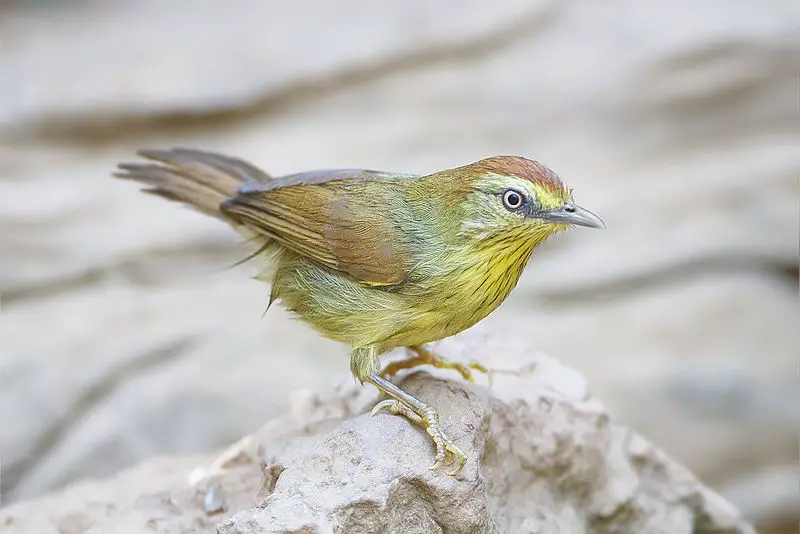
The Macronus gularis bird, commonly known as the Pin-Striped Tit-Babbler or Yellow-Breasted Babbler, is a species of Old World babbler found in South and Southeast Asia.
It was first described by American naturalist Thomas Horsfield in 1822 based on specimens collected from Sumatra.
The name ‘Macronus’ comes from the Greek words for “long” and “nose”, referring to its long beak.
They have brownish gray upperparts with paler underparts covered with bold black streaks along their sides and wings; they also have yellow throats which make them easily recognizable at a distance.
Macronus gularis are social birds that live in small groups of 3-10 individuals and communicate through loud calls such as chirps or trills but also use contact calls like whistles when separated from other members of their group.
Their diet consists mainly of insects, fruits, seeds, flowers buds – making them important pollinators.
Scientific classification:
| Kingdom | Animalia |
| Phylum | Chordata |
| Class | Aves |
| Order | Passeriformes |
| Family | Timaliidae |
| Genus | Mixornis |
| Species | M. gularis |
Also Featured In: Birds that Live in Kuala Lumpur, Most Common Tripura Birds You Need to Know
6. Black-Crested Bulbul
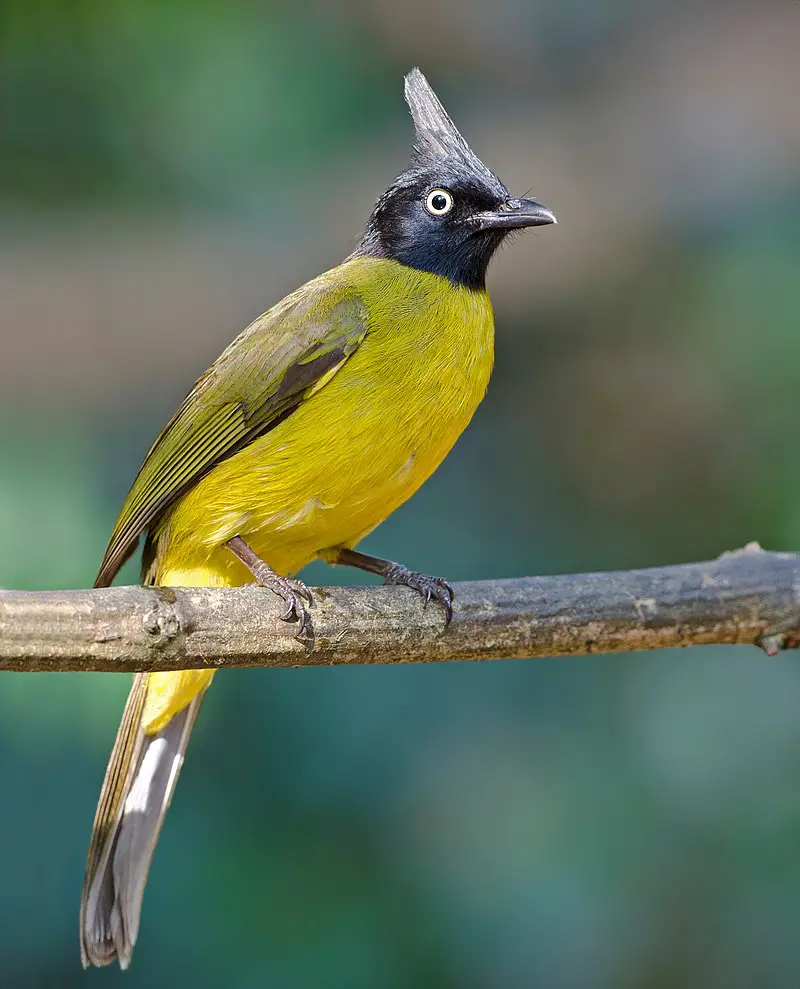
The Black-crested bulbul is a passerine bird belonging to the Bulbul Family. It can be found in India, Southeast Asia and other parts of the Indian subcontinent.
This species was first described under genus Vanga but later moved to Pycnonotus. However recent studies have revealed that this genus is polyphyletic leading five bulbuls including black-creasted ones to be placed in different genera.
The adult has an entirely black plumage with yellowish ventral side while juveniles are brownish grey above and whitish below having some pale streaks on their backsides as well.
Its diet consists mainly of fruits, insects and flower nectar which it feeds upon foraging among foliage or perching atop trees nearby water bodies like pools and streams.
Scientific classification:
| Kingdom | Animalia |
| Phylum | Chordata |
| Class | Aves |
| Order | Passeriformes |
| Family | Pycnonotidae |
| Genus | Rubigula |
| Species | R. flaviventris |
Also Featured In: Birds That You’ll See in Kaziranga National Park, Birds of Khao Yai National Park
7. Red-Billed Blue Magpie
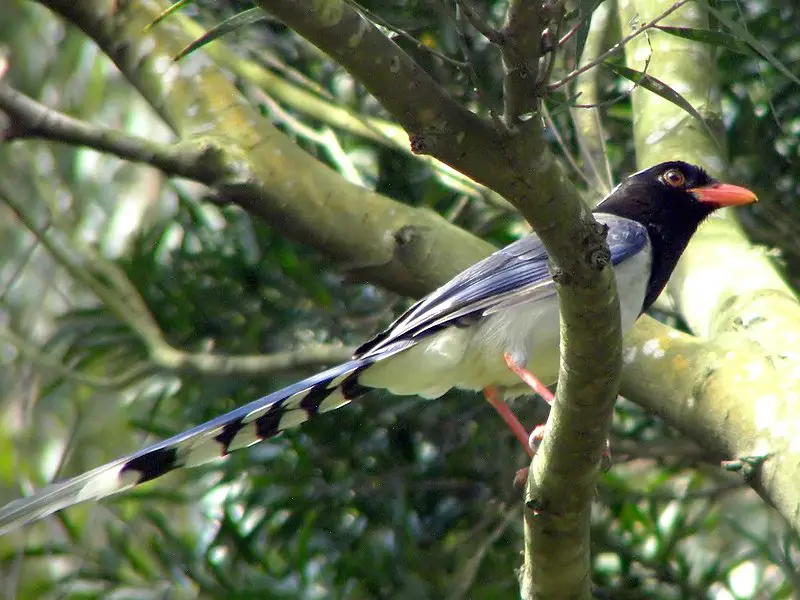
The Red-billed Blue Magpie is a beautiful bird, found in the crow family. It has an impressive size of 65 to 68 cm and weighs 196 – 232 g. Its tail length is one of the longest among other corvid species which makes it stand out even more.
This majestic looking creature was first described by French polymath Georges-Louis Leclerc, Comte de Buffon back in 1775.
The Red-billed blue magpie can be easily identified due to its stunning blue plumage with white underparts as well as red bill and feet.
Their call consists of either chattering or loud caws that they use while communicating with their flock members during flight or when foraging on ground together.
Scientific classification:
| Kingdom | Animalia |
| Phylum | Chordata |
| Class | Aves |
| Order | Passeriformes |
| Family | Corvidae |
| Genus | Urocissa |
| Species | U. erythroryncha |
8. Streaked Laughingthrush
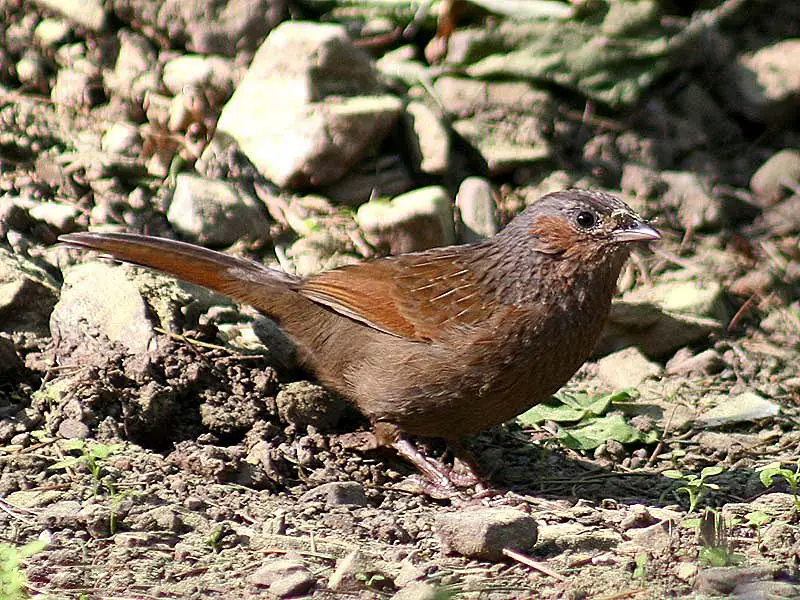
The Streaked Laughingthrush is a species of bird found mainly in the northern regions of the Indian subcontinent and some adjoining areas, such as Afghanistan, Bhutan, India, Nepal, Pakistan, Russia and Tajikistan.
It has distinctive white stripes on its head and back that contrast with its rufous-brown feathers. The birds usually inhabit dense forests where they feed on insects among other things.
They are social creatures often seen foraging together in flocks or pairs during daytime hours though they may also be active nocturnally too.
The subspecies imbricatum is sometimes considered to be a separate species; the Bhutan laughingthrush.
In Kullu Manali region it can commonly be spotted around water sources like rivers or streams looking out for food items while making their characteristic “laughing” call which helps them communicate with one another over long distances.
Scientific classification:
| Kingdom | Animalia |
| Phylum | Chordata |
| Class | Aves |
| Order | Passeriformes |
| Family | Leiothrichidae |
| Genus | Trochalopteron |
| Species | T. lineatum |
Also Featured In: Common Uzbekistan Birds,
9. Common Green Magpie
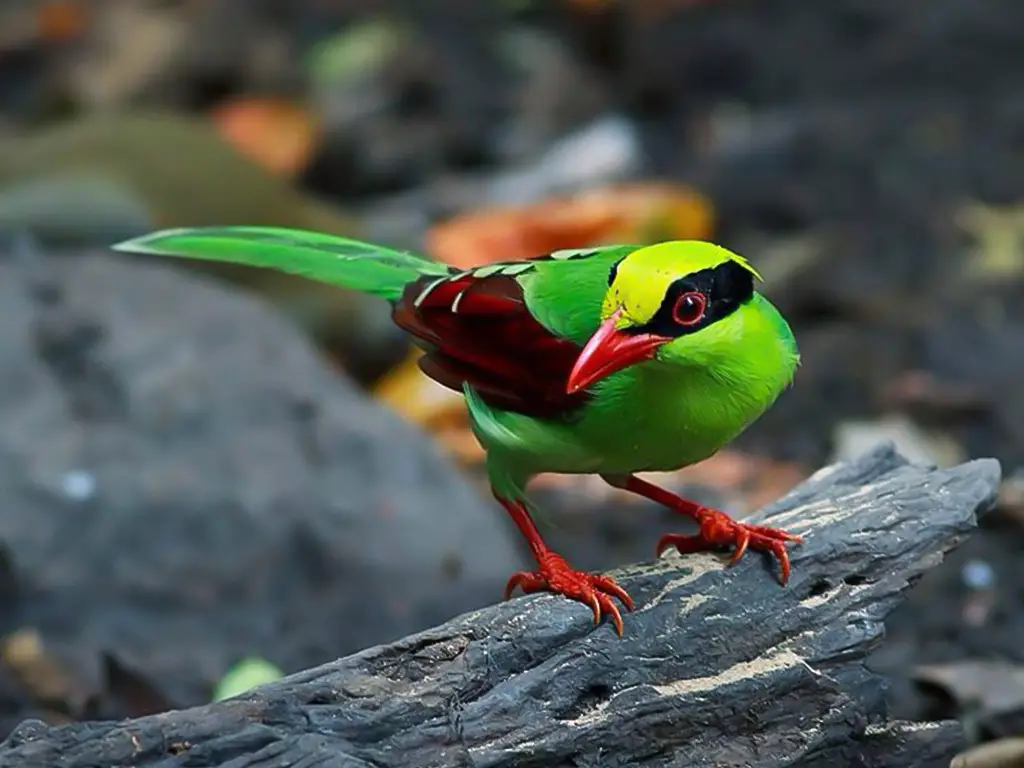
The Common green magpie is a stunningly beautiful bird belonging to the crow family. It has bright green feathers, slightly lighter on its underside and with a thick black stripe running from its bill through its eyes and down to the nape of its neck.
Growing roughly up to the size of a Eurasian jay or even smaller, its native habitat ranges across East Asia including India, China & Japan where they are often found in forests near water sources.
They have adapted well to human environments to make them popular as cage birds though their color can fade due to poor diet if not given carotenoid-based food regularly.
All in all these gorgeous birds make for both incredible wildlife sightings but also wonderful additions as pets.
Scientific classification:
| Kingdom | Animalia |
| Phylum | Chordata |
| Class | Aves |
| Order | Passeriformes |
| Family | Corvidae |
| Genus | Cissa |
| Species | C. chinensis |
10. Pin-Tailed Green Pigeon
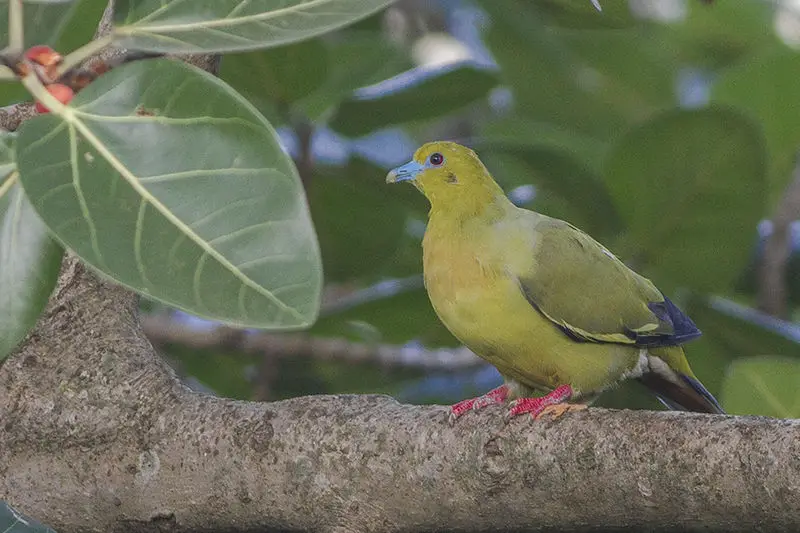
The Pin-tailed Green Pigeon is a stunning bird native to Southeast Asia. It has yellow-green plumage with darker green wing coverts and scapulars, as well as black outer secondaries and primaries.
Males are distinguished by their golden tail feathers which give this species its name. They have an average weight of 185 – 255 grams and measure between 28 cm (females) up to 36 cm (males).
These beautiful birds often inhabit open forests or woodlands in search for food such as fruit, seeds, buds and blossoms.
The Pin-tailed Green Pigeon will make an excellent addition to any aviary.
Scientific classification:
| Kingdom | Animalia |
| Phylum | Chordata |
| Class | Aves |
| Order | Columbiformes |
| Family | Columbidae |
| Genus | Treron |
| Species | T. apicauda |
Also Featured In: Birds of Jim Corbett National Park,
11. Black-Headed Jay
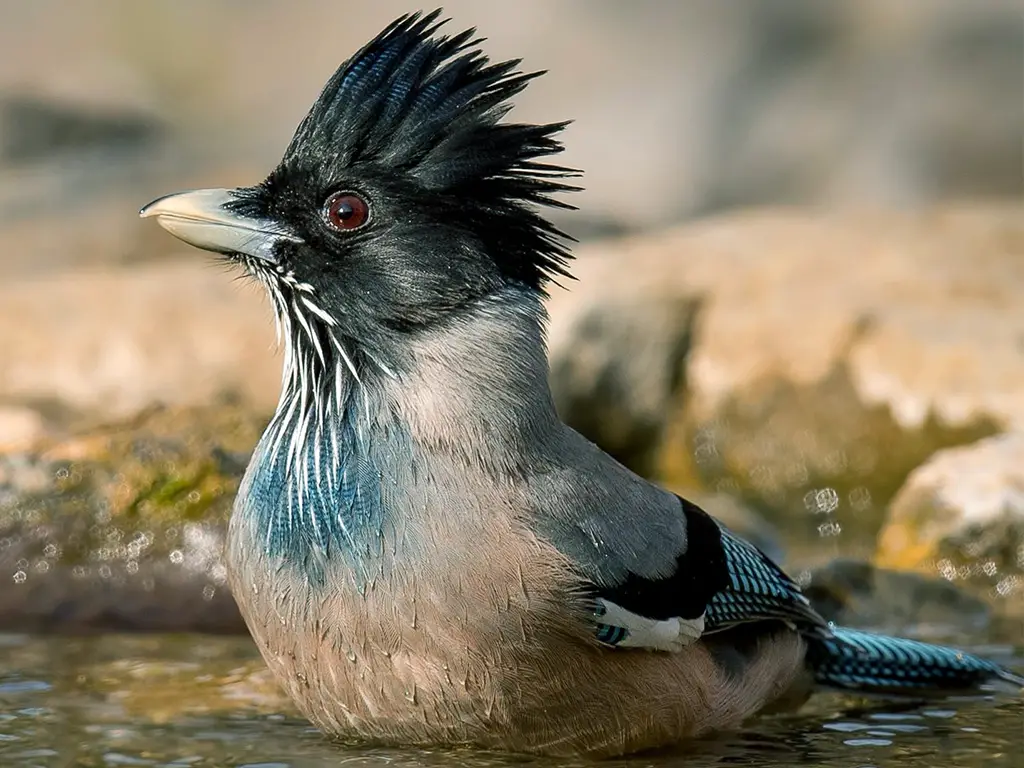
The Black-headed Jay is a stunning bird with its black head and crest, contrasting against the brown feathers of its body. It has long tail feathers that give it an elongated appearance.
This species can be found in Eastern Afghanistan, across the Himalayas to India, Nepal and Bhutan. They are roughly similar size as Eurasian jays but have slightly shorter and thicker bills.
These birds forage on ground level for insects or seeds which they store in their crop before taking them back to their roosts where they feed others from their stash – this behaviour makes them quite popular among farmers.
In addition they also eat fruits such as berries when available during winter months providing food sources for other animals too due to regurgitation of undigested remains.
Scientific classification:
| Kingdom | Animalia |
| Phylum | Chordata |
| Class | Aves |
| Order | Passeriformes |
| Family | Corvidae |
| Genus | Garrulus |
| Species | G. lanceolatus |
12. Bar-Tailed Treecreeper
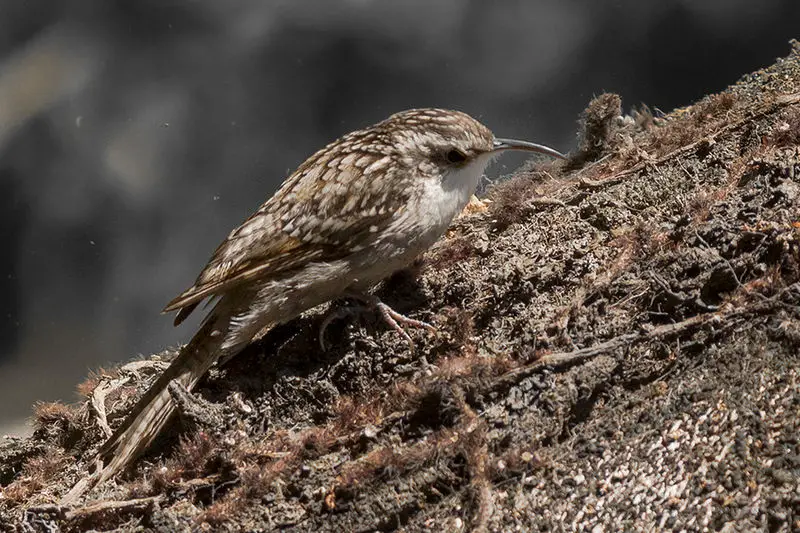
The Bar-tailed Treecreeper is a species of bird found in the northern parts of the Indian subcontinent, including Afghanistan, India, Iran and Nepal.
It has adapted to live mainly in coniferous forests and rocky hillsides at an altitude range from 1000m – 4500m.
Its plumage is generally greyish brown above with white underparts and rufous wings; it also bears a small bill which helps them seek out insects hidden deep within tree bark or cracks.
They are agile climbers who creep up trunks searching for food such as ants and other tiny invertebrates using their long curved claws.
The Himalayan Treecreeper can often be seen clambering around trees during its active hours between dawn till dusk making loud calls that sound like “chick chick”.
Scientific classification:
| Kingdom | Animalia |
| Phylum | Chordata |
| Class | Aves |
| Order | Passeriformes |
| Family | Certhiidae |
| Genus | Certhia |
| Species | C. himalayana |
13. Lesser Racket-Tailed Drongo
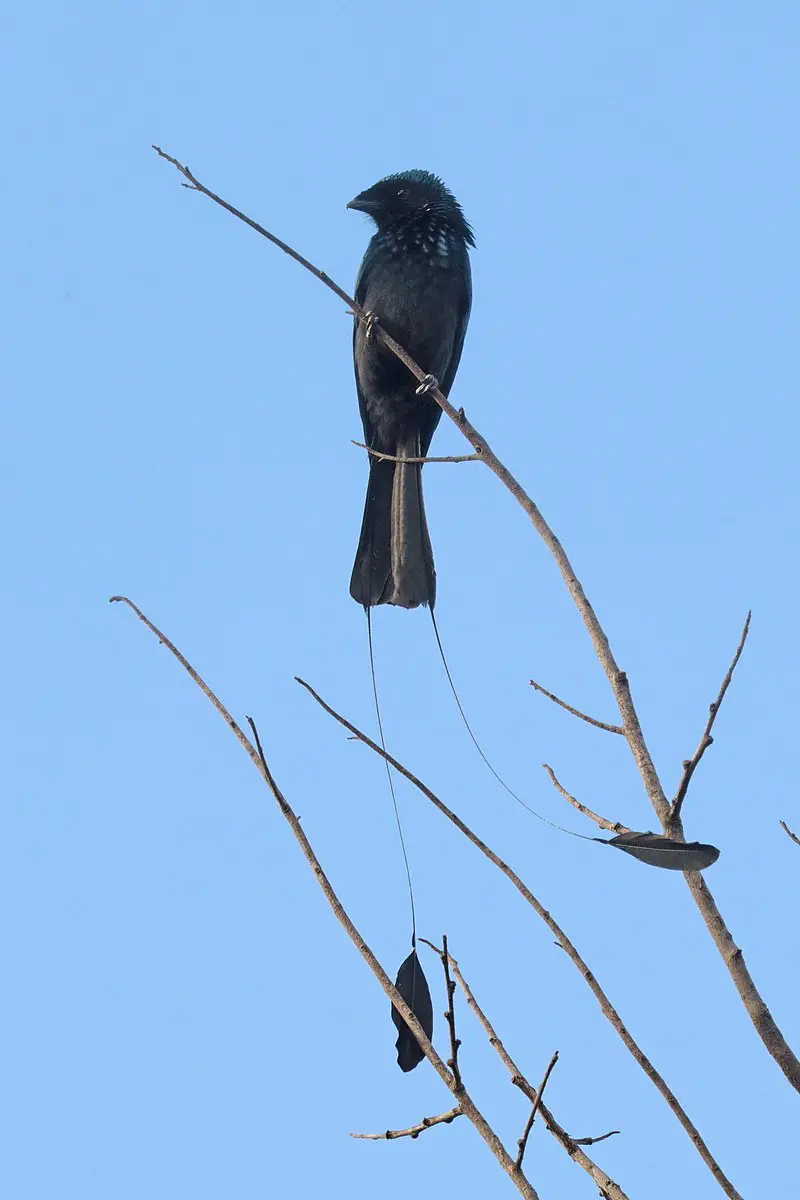
The Lesser racket-tailed drongo is a beautiful bird found in the Indian Subcontinent and Southeast Asia. It can reach up to 25–27·5 cm long, excluding its famously long tail feathers which can add another 10–15cm onto its length.
This species has an average weight of 39–49g for males and 35·5 –44 g for females, helping to differentiate it from the Greater Racket-Tailed Drongo.
These birds are known for their glossy black plumage with white spots on their wings as well as two distinctive ‘rackets’ at the end of their tails – giving them one of the longest tails compared to other members of this family.
They also have curved beaks perfect for catching insects and fruit which make up majority of their diet.
Scientific classification:
| Kingdom | Animalia |
| Phylum | Chordata |
| Class | Aves |
| Order | Passeriformes |
| Family | Dicruridae |
| Genus | Dicrurus |
| Species | D. remifer |
14. Variegated Laughingthrush
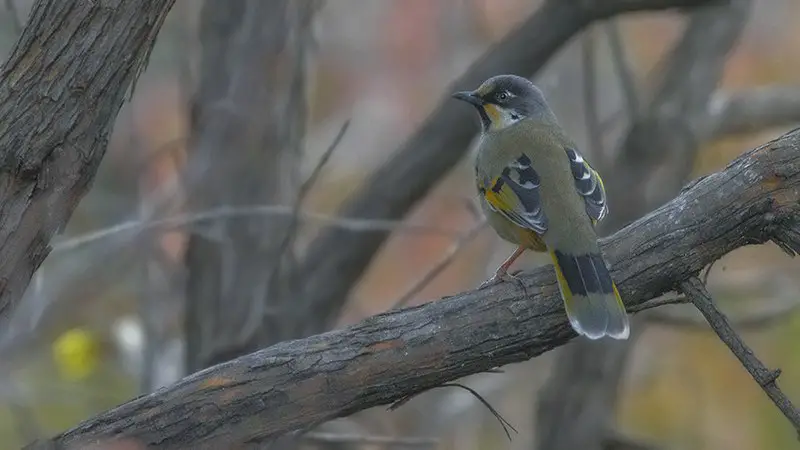
The Variegated Laughingthrush is a beautiful species of bird found primarily in the northern regions of India, Bhutan, Nepal and Tibet. Endemic to low-to-mid altitudes of the Himalayas, it has stunning plumage consisting of black and white markings on its wings and tail feathers.
This medium-sized laughingthrush measures between 24 – 26 cm long and typically weighs 57 – 79 grams. It’s known for having a loud call which can be heard from some distance away.
As with many other birds in this region, habitat destruction poses one of the biggest threats to their existence; however conservation efforts are being made to protect these amazing creatures.
Scientific classification:
| Kingdom | Animalia |
| Phylum | Chordata |
| Class | Aves |
| Order | Passeriformes |
| Family | Leiothrichidae |
| Genus | Trochalopteron |
| Species | T. variegatum |
15. Abbott’s Babbler
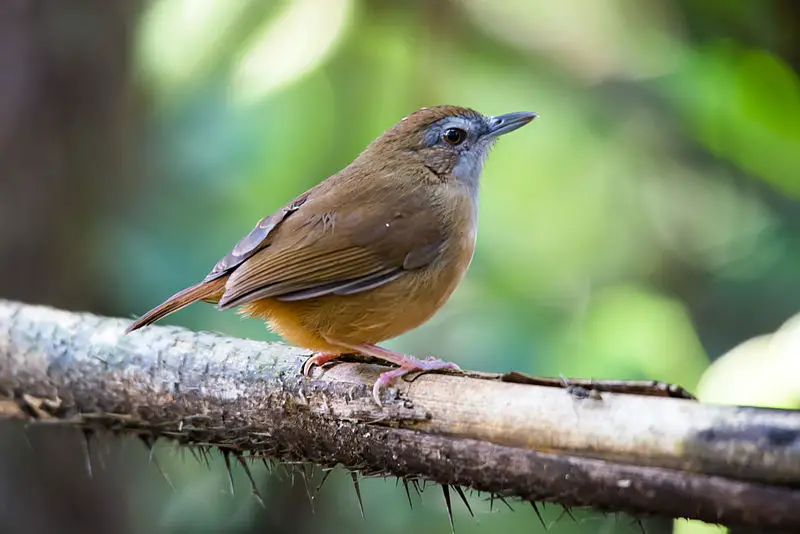
Abbott’s babbler is a unique bird that can be found along the Himalayas and in South Asia. It has a short tail and stout body, making it easily identifiable among other birds.
The Abbott’s babbler forages close to the ground in pairs, usually hidden within dense undergrowth or vegetation. They are known for their distinctive calls which reveal their presence even when they cannot be seen.
This species was first described by English zoologist Edward Blyth back in 1845 and since then it has been well studied due to its popularity among avian enthusiasts. Abbott’s babblers typically inhabit forests but have also been sighted in agricultural areas such as tea plantations with open grassland habitats nearby.
Scientific classification:
| Kingdom | Animalia |
| Phylum | Chordata |
| Class | Aves |
| Order | Passeriformes |
| Family | Pellorneidae |
| Genus | Malacocincla |
| Species | M. abbotti |
16. Black-Eared Shrike-Babbler
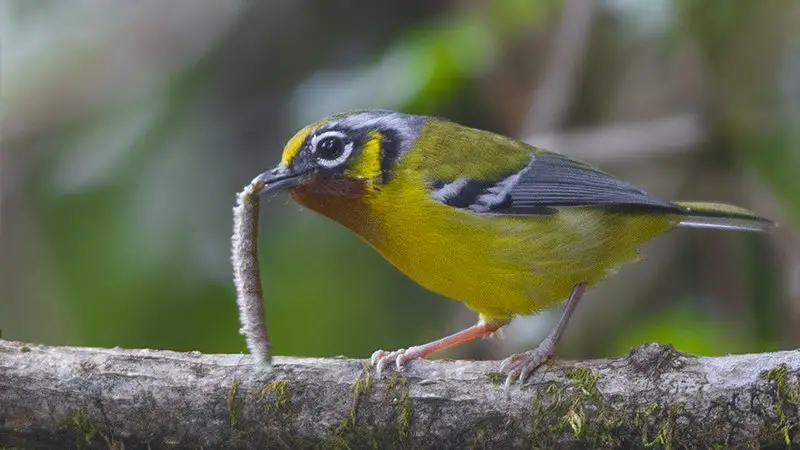
The black-eared shrike-babbler is a species of bird in the Vireonidae family found throughout Southeast Asia, particularly in the Himalayas.
Its behavior and habits resemble those of vireos due to convergent evolution, although it was traditionally considered an aberrant Old World babbler placed within the Timaliidae family.
This small bird has distinct black ear patches with white borders against its brown upperparts and greyish underparts.
It feeds on insects such as grasshoppers, caterpillars and other invertebrates while foraging among foliage or branches near forest edges.
They also eat fruits like figs during winter months when insect availability decreases significantly.
The Black-eared shrike-babbler is usually seen alone or in pairs interacting through calls that create melodious sounds echoing across their native forests habitats.
Scientific classification:
| Kingdom | Animalia |
| Phylum | Chordata |
| Class | Aves |
| Order | Passeriformes |
| Family | Vireonidae |
| Genus | Pteruthius |
| Species | P. melanotis |
Also Featured In: Birds that Commonly Found in Andhra Pradesh,
17. Whiskered Yuhina
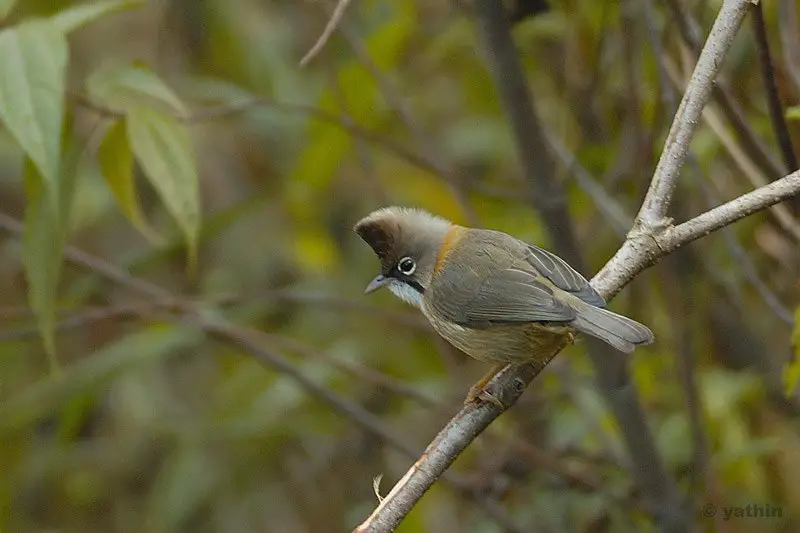
The Whiskered Yuhina is a small bird species that can be found in the Himalayan forests of Northern India, Nepal, Bhutan and Bangladesh. It also inhabits Indochina including Laos, Myanmar, Thailand and Vietnam.
This beautiful creature has gray upper parts along with white underparts while its head has black-and-white stripes across it. Its natural habitat includes subtropical or tropical moist montane forests where they are usually seen in flocks foraging through trees for insects and nectar from flowers as their primary diet source.
Despite its declining population due to deforestation activities this species still remains common throughout much of its range with conservation measures being put into place by local governments to protect them from further degradation of habitats which will help maintain healthy populations for generations to come.
Scientific classification:
| Kingdom | Animalia |
| Phylum | Chordata |
| Class | Aves |
| Order | Passeriformes |
| Family | Zosteropidae |
| Genus | Yuhina |
| Species | Y. flavicollis |
18. Black-Chinned Yuhina
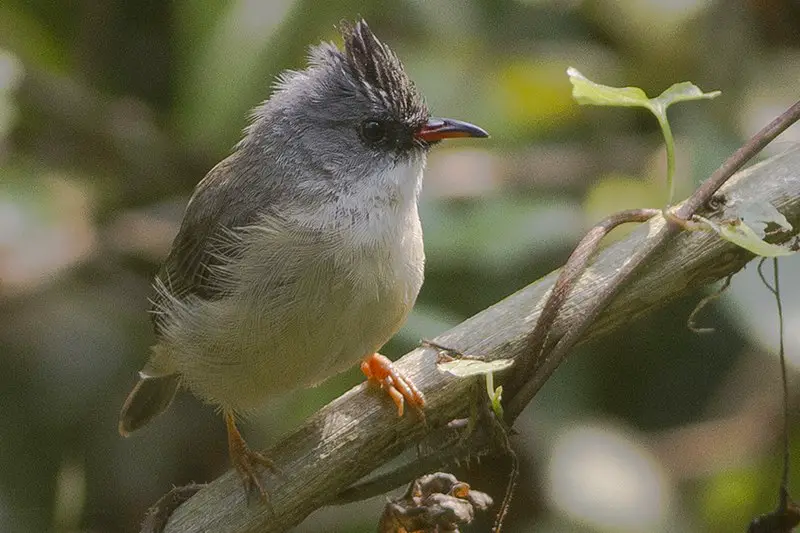
The Black-chinned Yuhina is a small bird belonging to the white-eye family Zosteropidae.
It can be found in various parts of India and Southeast Asia, from Himalayan regions eastward down through Bangladesh, Bhutan, Cambodia, Laos , Myanmar Nepal Tibet and Thailand.
These birds prefer subtropical or tropical moist lowland forests for their habitat where they feed on insects like termites that are commonly found there.
In addition to being active during day time hours these little creatures often form large flocks with other species like barbets and cuckoos when looking for food sources.
They have remarkable black chins which distinguishes them among other members of this family making them quite unique.
Scientific classification:
| Kingdom | Animalia |
| Phylum | Chordata |
| Class | Aves |
| Order | Passeriformes |
| Family | Zosteropidae |
| Genus | Yuhina |
| Species | Y. nigrimenta |
19. Bay Woodpecker
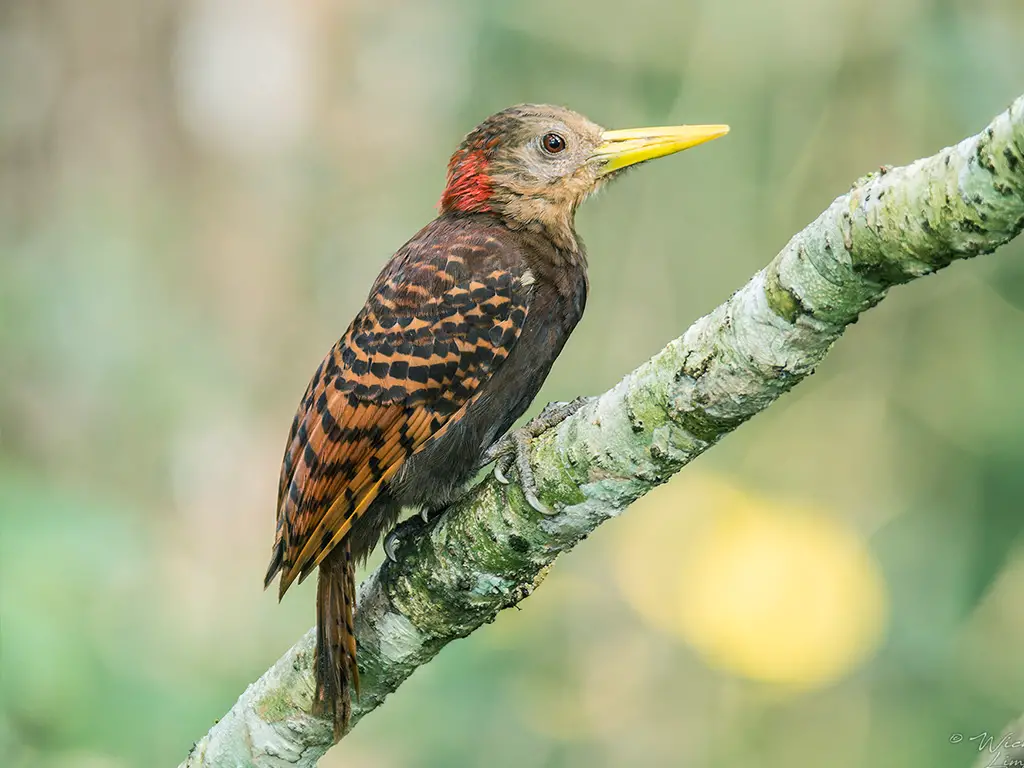
The Bay Woodpecker is a species of bird found in many parts of Asia, from Bangladesh to Vietnam. This small but colorful bird lives in subtropical or tropical moist lowland and montane forests.
It has an olive-brown back with white barring on the wings and tail feathers, while its belly is yellowish-white spotted with cinnamon brown. Its diet consists mainly of insects such as ants, beetles, termites and caterpillars.
The call of this woodpecker can be heard echoing through the trees – it’s a loud “krrr” noise.
As well as foraging for food alone or in pairs during the day time, they also use their long bills to excavate nest cavities high up into tree trunks where they lay eggs at night time.
These birds are important seed dispersers due to their constant movement between habitats which helps spread new varieties of plants throughout different areas – making them essential components within local ecosystems.
Scientific classification:
| Kingdom | Animalia |
| Phylum | Chordata |
| Class | Aves |
| Order | Piciformes |
| Family | Picidae |
| Genus | Blythipicus |
| Species | B. pyrrhotis |
20. Brown-Fronted Woodpecker
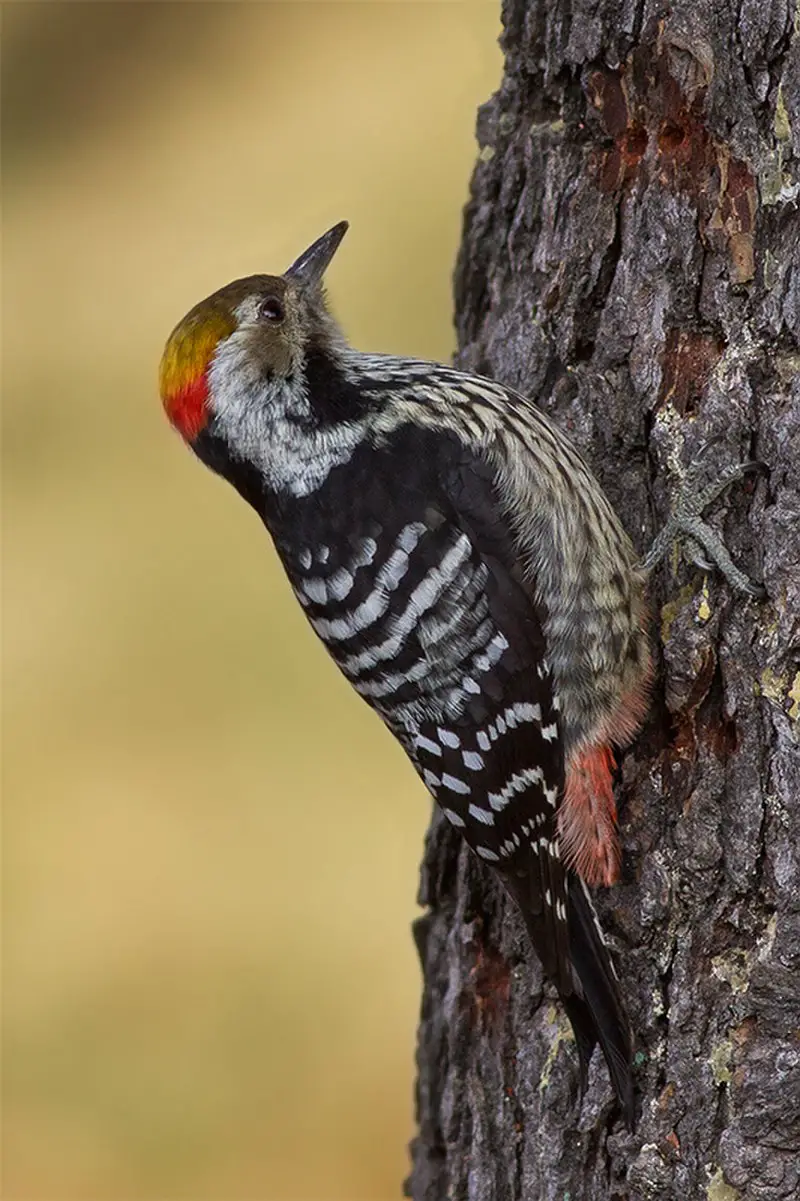
The Brown-fronted Woodpecker is a species of bird that belongs to the Picidae family. It inhabits the northern regions of India, primarily in lower and middle altitudes of Himalayas, as well as Afghanistan, Nepal, Pakistan and Bhutan.
These birds are known for their distinct brown front with white spots on either side near its forehead. They typically feed on ants and other insects which they find by tapping or pecking at tree bark with their strong beaks.
Besides insect prey these woodpeckers also occasionally eat fruits such as berries from nearby trees too.
Taxonomically speaking this species may belong to either Dendrocopos or Leiopicus genera depending upon various authorities; however both agree on one thing – it’s an amazing sight to behold when you spot them flitting around looking for food.
Scientific classification:
| Kingdom | Animalia |
| Phylum | Chordata |
| Class | Aves |
| Order | Piciformes |
| Family | Picidae |
| Genus | Dendrocoptes |
| Species | D. auriceps |
21. Darjeeling Woodpecker
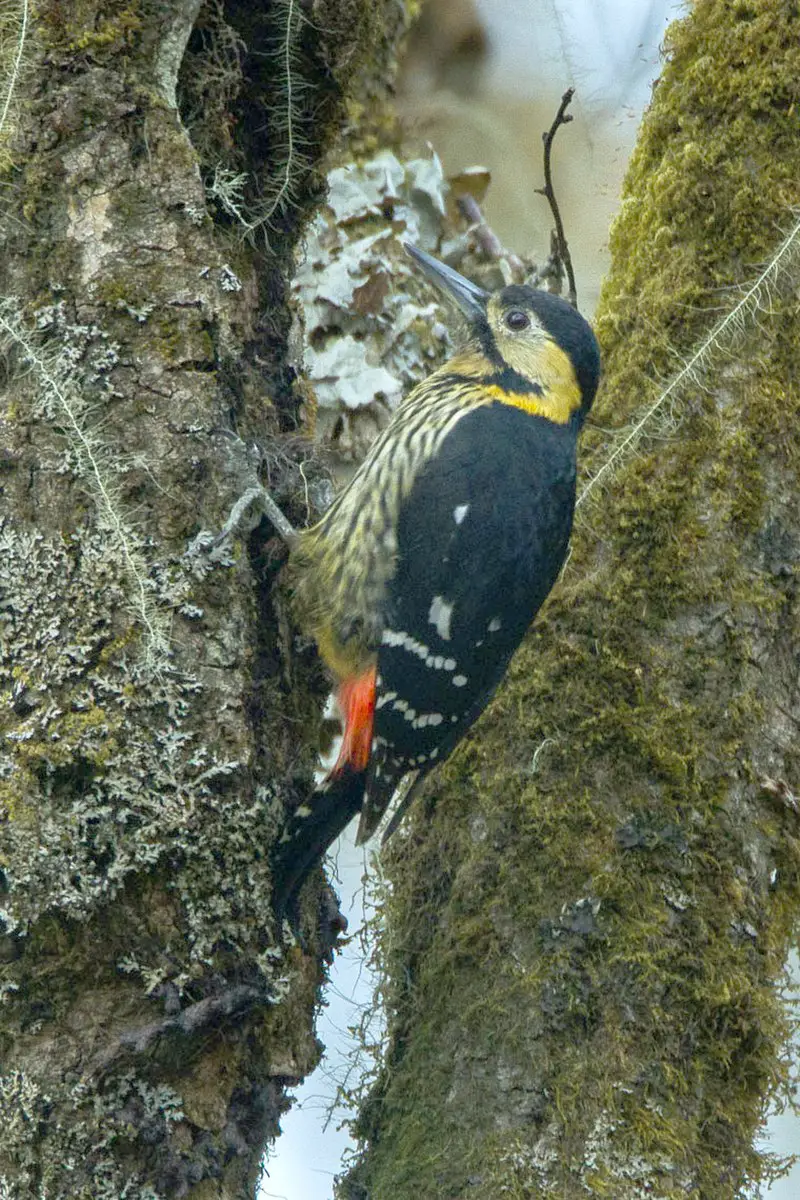
The Darjeeling woodpecker is a beautiful species of bird found in the Himalayan region and northern parts of India. It has black upperparts with white scapular patches, while its neck sides are yellow.
The male also has a red nape patch on the back of its head. Its flight feathers and tail sides have white bars, making it stand out from other birds in this area.
This medium-sized pied woodpecker can be easily recognized by its distinct colouring pattern which helps distinguish it from similar looking species like Lesser Yellownape Woodpeckers or Streak-throated Woodpeckers that reside in these regions as well.
Scientific classification:
| Kingdom | Animalia |
| Phylum | Chordata |
| Class | Aves |
| Order | Piciformes |
| Family | Picidae |
| Genus | Dendrocopos |
| Species | D. darjellensis |
22. Black-Hooded Oriole
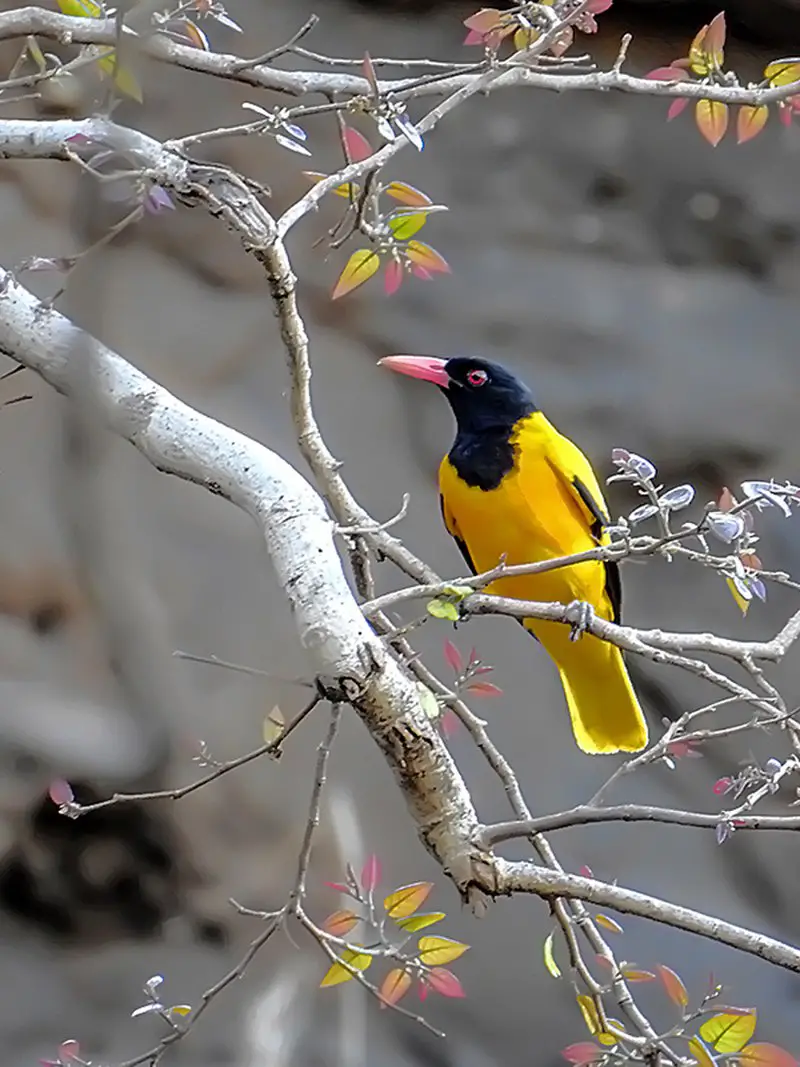
The Black-hooded Oriole is a beautiful and unique bird found in tropical southern Asia. It has black feathers on its head, giving it the name “black hooded”.
Its diet consists of insects, fruit, especially figs which can be found in the tree canopy where they spend most of their time. They build nests high up on trees to lay their eggs – usually two per nest.
The orioles are active during daybreak and nightfall when they search for food or mates. Their bright colors make them noticeable even from afar making them an interesting sight for any nature lover with a keen eye.
Scientific classification:
| Kingdom | Animalia |
| Phylum | Chordata |
| Class | Aves |
| Order | Passeriformes |
| Family | Oriolidae |
| Genus | Oriolus |
| Species | O. xanthornus |
Also Featured In: Birds of Goa, Common Birds in Kerala
23. Bar-Winged Flycatcher-Shrike
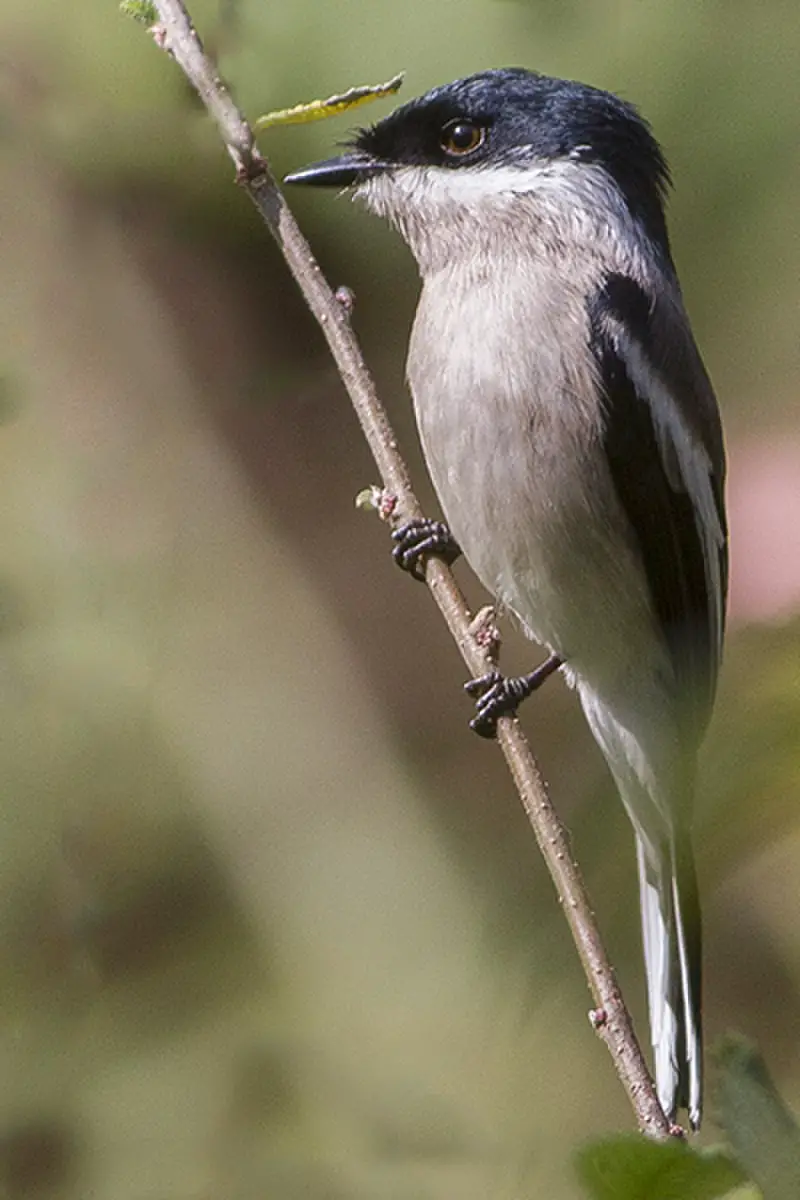
The Bar-winged Flycatcher-Shrike is a small passerine bird found in the forests of tropical southern Asia, ranging from the Himalayas and hills of India to Indonesia.
These birds inhabit mid-canopy levels in the forest, often joining mixed species flocks while they search for food.
With its distinctive pattern of black and white plumage on its head and wings, this flycatcher can be easily identified by experienced bird watchers.
They are mainly insectivorous birds that feed upon insects such as moths, beetles and flies which they capture using their sharp bill or talons during flight.
The bar-winged flycatcher has adapted well to life in these woodlands with an agile nature allowing it to navigate quickly through dense foliage when searching for prey or evading predators.
Scientific classification:
| Kingdom | Animalia |
| Phylum | Chordata |
| Class | Aves |
| Order | Passeriformes |
| Family | Vangidae |
| Genus | Hemipus |
| Species | H. picatus |
Also Featured In: Common Birds that Live in Odisha,
24. Black Baza
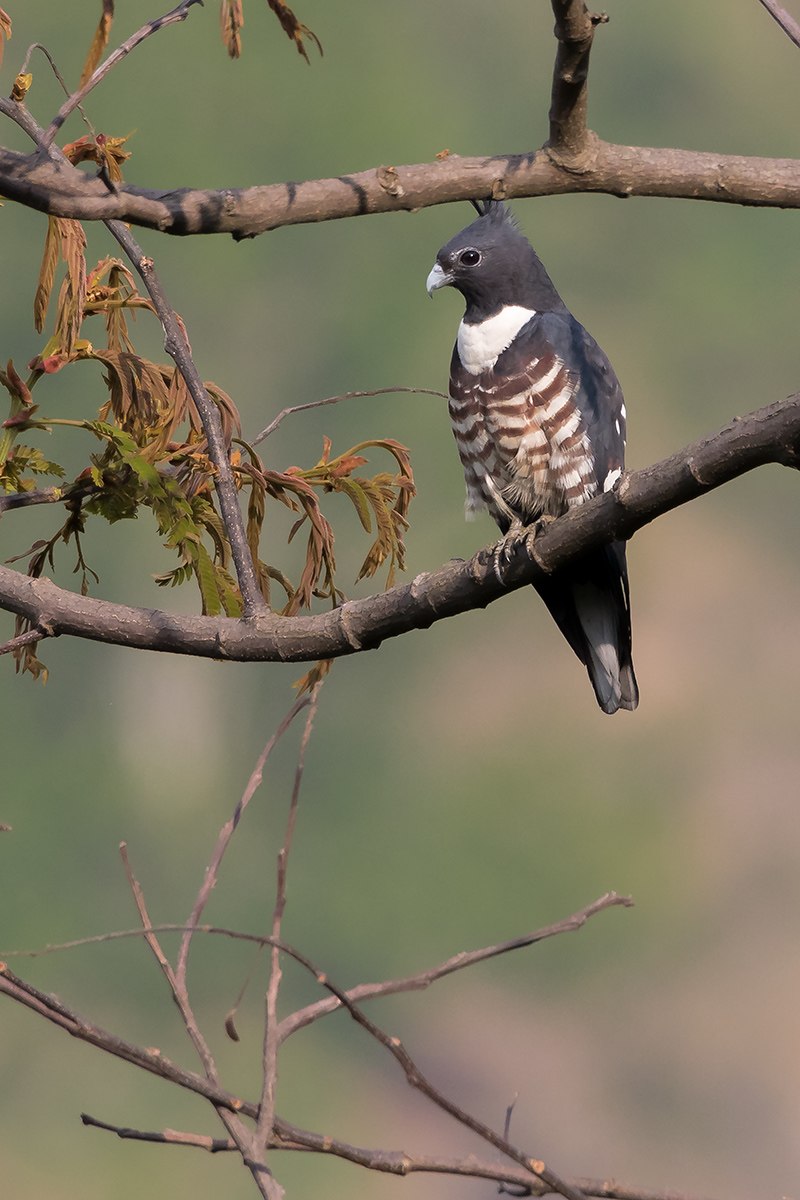
The Black Baza is a small bird of prey found in the forests of Northeast India, Eastern Himalayas. China and Southeast Asia. It has short stout legs with strong talons for gripping its prey and sports a prominent crest atop its head.
During winter season many populations migrate to south Peninsula and Sri Lanka where they can find food more easily than their native habitats dense forest areas.
The black bazas diet consists mainly of insects, lizards, small birds or mammals as well as fruits like figs which make up about 45% of what it eats during summer months when insect availability is low around them.
Scientific classification:
| Kingdom | Animalia |
| Phylum | Chordata |
| Class | Aves |
| Order | Accipitriformes |
| Family | Accipitridae |
| Genus | Aviceda |
| Species | A. leuphotes |
Also Featured In: Birds that Migrate to Sri Lankan, Common Birds of Indonesia
25. Brown-Flanked Bush Warbler
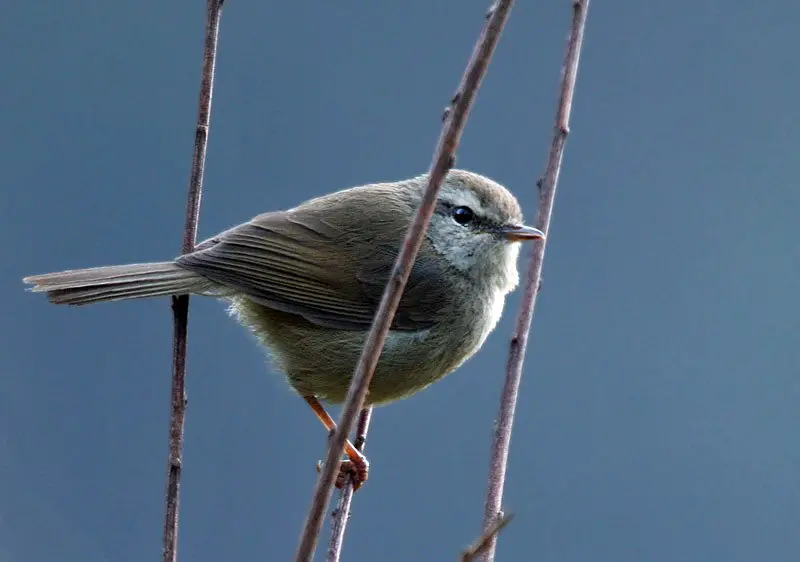
The brown-flanked bush warbler is a species of bird found in South Asia. It belongs to the family Cettiidae, and was previously classified as an Old World Warbler.
This small songbird has primarily yellowish green plumage; its back and wings are darker than its breast, which sports faint streaks of light brown coloration along the flanks.
Its diet consists mainly of insects caught on foliage or during short flights between trees foraging for food.
The Brown-Flanked Bush Warbler nests in dense shrubs near water sources, where it will also sing loudly during both morning and evening hours throughout late spring time when they are most active before migrating southward until returning again next year with warmer temperatures.
Scientific classification:
| Kingdom | Animalia |
| Phylum | Chordata |
| Class | Aves |
| Order | Passeriformes |
| Family | Cettiidae |
| Genus | Horornis |
| Species | H. fortipes |
26. Nepal House Martin
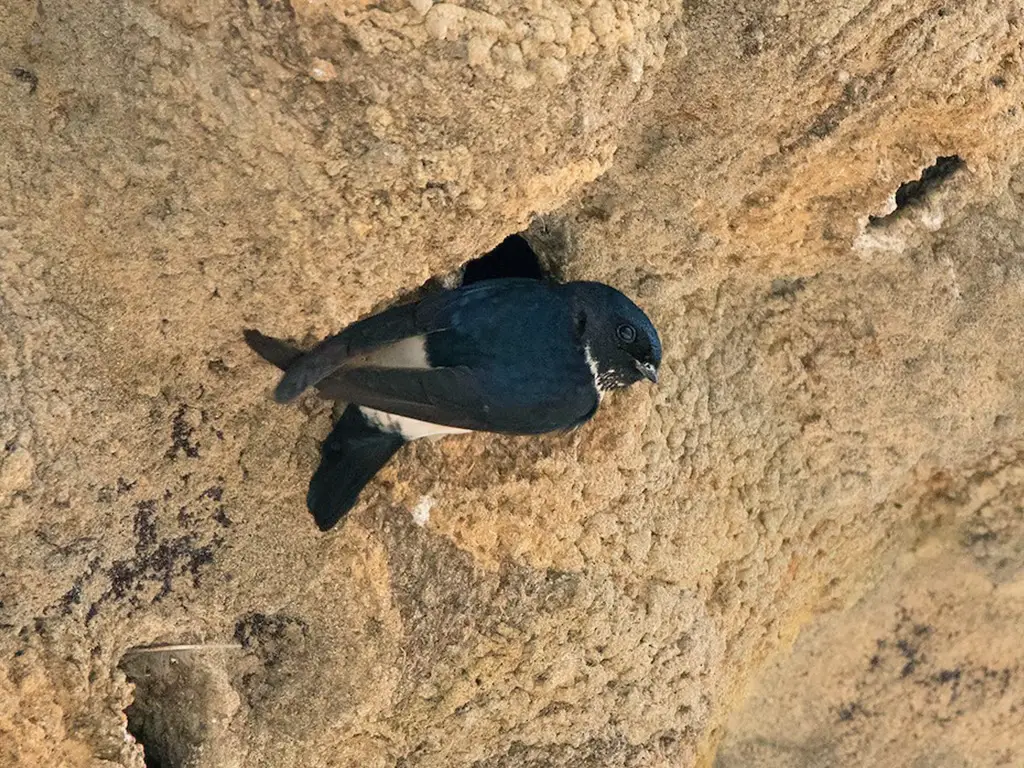
The Nepal house martin is a small passerine bird belonging to the swallow family Hirundinidae. It has two subspecies which breed in the Himalayas from northwestern India through Nepal, Myanmar and northern Vietnam up to China.
They inhabit river valleys and wooded mountain ridges at altitudes between 1,000-4,000m where they nest in large colonies beneath overhangs of rocks or buildings with open eaves.
The birds are non-migratory but may wander locally within their range during winter months when food can be scarce.
Their diet consists mainly of flying insects such as flies, wasps and bees which they catch on short flights above fields near water sources. These charming little birds have white underparts with brownish upper parts making them easily recognizable for those lucky enough to spot one.
Scientific classification:
| Kingdom | Animalia |
| Phylum | Chordata |
| Class | Aves |
| Order | Passeriformes |
| Family | Hirundinidae |
| Genus | Delichon |
| Species | D. nipalense |
27. Fire-Tailed Sunbird
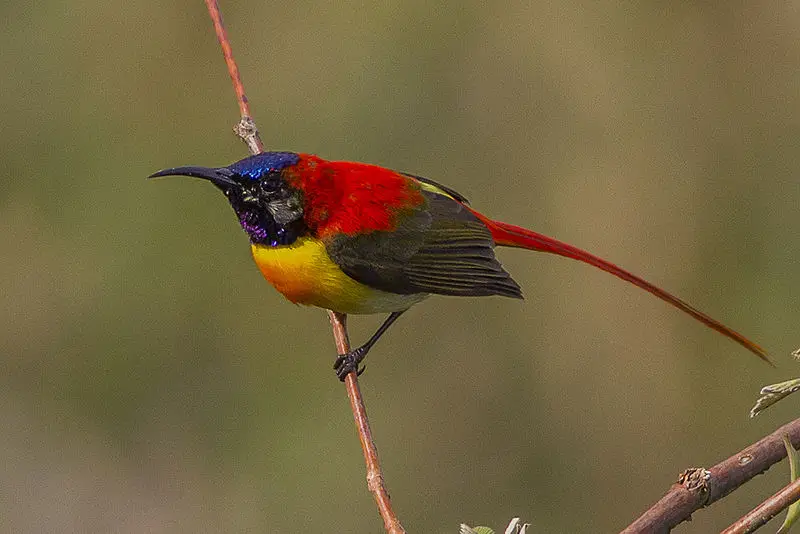
The Fire-tailed Sunbird is a stunning species of sunbird that can be found in the northern parts of India, Bangladesh, Bhutan, Myanmar, Nepal and Tibet.
It typically inhabits temperate forests and subtropical or tropical areas. This bird has an attractive appearance with its bright yellow chestnut head crest along with its red tail feathers.
The males possess long metallic green upperparts whereas females have brownish grey plumage on their backside.
Also they both feature reddish bills which are used to feed nectar from flowers as well as small insects like flies and grasshoppers for protein consumption .
They prefer to build nests high up near streamsides where water sources are easily accessible during all seasons of the year making it easier for them to survive in harsh climates during winter months.
Scientific classification:
| Kingdom | Animalia |
| Phylum | Chordata |
| Class | Aves |
| Order | Passeriformes |
| Family | Nectariniidae |
| Genus | Aethopyga |
| Species | A. ignicauda |
28. Dark-Breasted Rosefinch
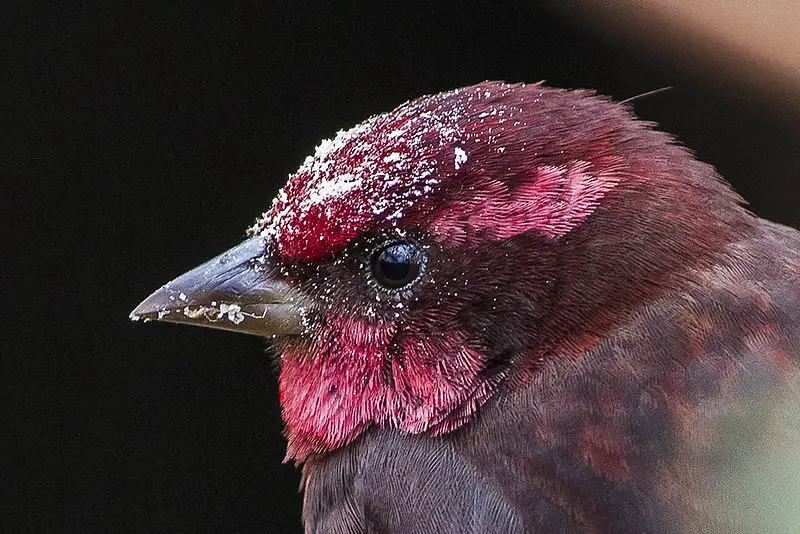
The Dark-breasted Rosefinch is a stunning species of true finch found across Asia in countries such as Bhutan, China, India, Laos and Vietnam.
This small bird has an unmistakable plumage with its dark brown chest contrasted against light grey wings and tail feathers.
It inhabits boreal forests and subtropical or tropical high-altitude shrublands where it feeds on seeds from pine trees as well as insects.
The genus Procarduelis was created specifically for this species because of their unique features which differ from other true finches like the House Finch or Goldfinches.
They are social birds that form tight flocks when searching for food sources throughout winter months but during breeding season they become more solitary creatures yet remain loyal to the same nesting sites year after year.
Scientific classification:
| Kingdom | Animalia |
| Phylum | Chordata |
| Class | Aves |
| Order | Passeriformes |
| Family | Fringillidae |
| Subfamily | Carduelinae |
| Genus | Procarduelis Blyth, 1843 |
| Species | P. nipalensis |
29. Pink-Browed Rosefinch
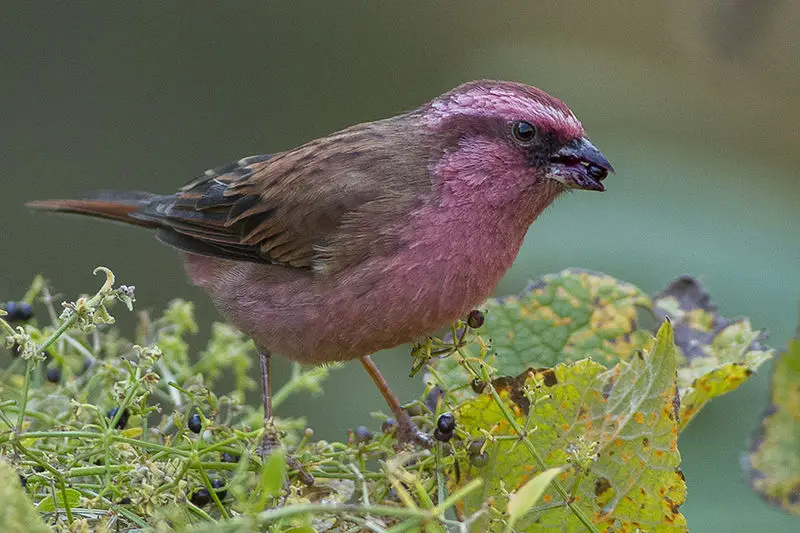
The Pink-browed Rosefinch is a beautiful bird found in the northern regions of the Indian subcontinent, mainly in the Himalayas. It has an unmistakable pinkish brow and upperparts, with a white belly and black wings.
During its migration it can be seen across Bhutan, Tibet, India, Nepal and Pakistan. This finch prefers boreal forests or dry subtropical climates but also visits open woodlands for feeding purposes.
Its diet consists mostly of seeds from grasses as well as other small plants such as clover or thistle flowers; insects are also reported to make up part of their diet during breeding season when extra protein sources are needed for chicks growth development .
With its vibrant plumage colors this species makes a spectacular sight.
Scientific classification:
| Kingdom | Animalia |
| Phylum | Chordata |
| Class | Aves |
| Order | Passeriformes |
| Family | Fringillidae |
| Subfamily | Carduelinae |
| Genus | Carpodacus |
| Species | C. rodochroa |
30. Blanford’s Rosefinch
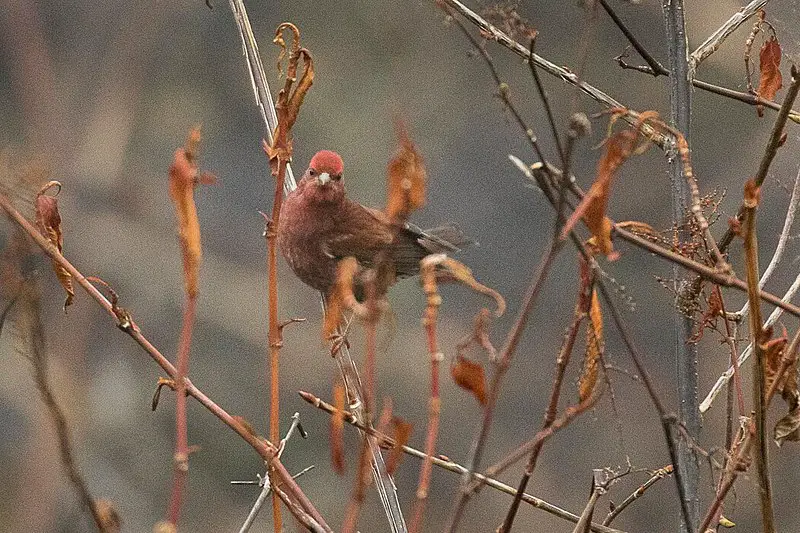
Blanford’s rosefinch is a species of finch found in Bhutan, China, India and Nepal. They inhabit boreal forests and were formerly placed in the genus Carpodacus with other rosefinches.
However, recent phylogenetic analysis shows that they are distinct enough to be classified as their own monotypic genus Agraphospiza.
These birds have striking crimson feathers which make them stand out from other nearby species.
Their diet mainly consists of seeds but also includes nuts, fruits and insects when available during breeding season.
Blanford’s Rosefinch has an interesting habitat preference; while usually seen near coniferous trees they can often be spotted around human habitations such as farmsteads or gardens due to their fondness for cultivated grains like wheat or millet.
Scientific classification:
| Kingdom | Animalia |
| Phylum | Chordata |
| Class | Aves |
| Order | Passeriformes |
| Family | Fringillidae |
| Subfamily | Carduelinae |
| Genus | Agraphospiza Zuccon, Prŷs-Jones, Rasmussen & Ericson, 2012 |
| Species | A. rubescens |
31. Black-And-Yellow Grosbeak
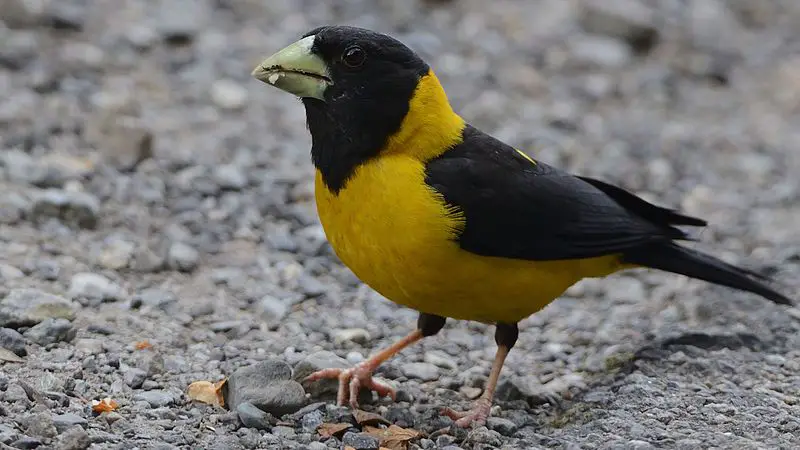
The Black-and-yellow Grosbeak is a species of finch native to northern parts of the Indian subcontinent, primarily in lower and middle Himalayas. It has an unmistakable black head with yellow wings, back and breast which makes it easily identifiable from other birds.
This bird can be found in temperate forests across Afghanistan, India, Iran Nepal and Pakistan. The female grosbeaks have slightly duller colours than males but are still quite striking to look at due to their bright plumage.
They feed on the ground for insects as well as fruits like berries or seeds from trees or shrubs making them omnivores by nature .
All in all ,the Black-andYellow Grosbeak is a beautiful addition to any forest landscape that deserves more recognition for its beauty.
Scientific classification:
| Kingdom | Animalia |
| Phylum | Chordata |
| Class | Aves |
| Order | Passeriformes |
| Family | Fringillidae |
| Subfamily | Carduelinae |
| Genus | Mycerobas |
| Species | M. icterioides |
32. Brown Accentor
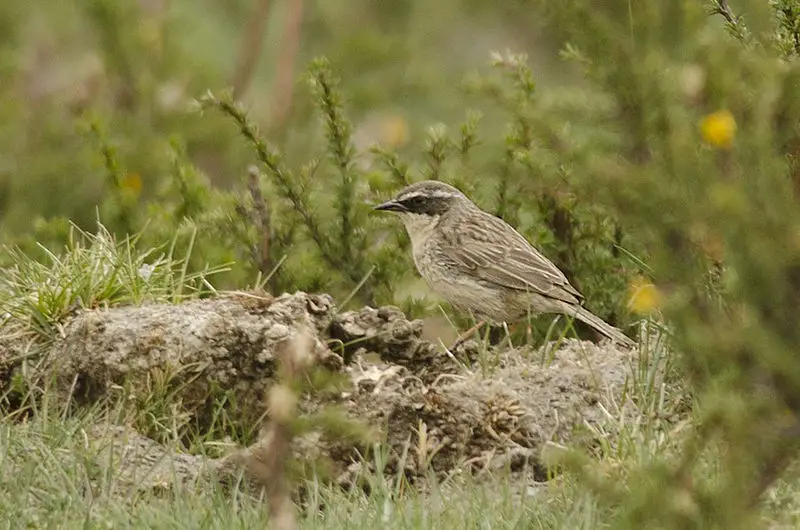
The Brown Accentor is a small bird native to parts of Central Asia and the Middle East. It belongs to the Prunellidae family, which includes some of Europe’s most common passerines.
This species has brown upperparts with lighter spots on its chest and back, while its head and throat are light greyish-white in coloration.
Its underparts are whitish or yellowish-buff that fades into a dark rusty hue at the tail tip.
The Brown Accentor feeds mainly on insects it finds foraging through ground vegetation like low shrubs or grasses but also eats seeds when available.
As such, it prefers dry Mediterranean habitats with sparsely vegetated areas where there is ample food availability throughout the year.
Though relatively widespread across much of their range due to an adaptable nature, this species can be threatened by habitat destruction caused by human activities such as agricultural expansion or urbanization.
Scientific classification:
| Kingdom | Animalia |
| Phylum | Chordata |
| Class | Aves |
| Order | Passeriformes |
| Family | Prunellidae |
| Genus | Prunella |
| Species | P. fulvescens |
33. Bengal Bush Lark
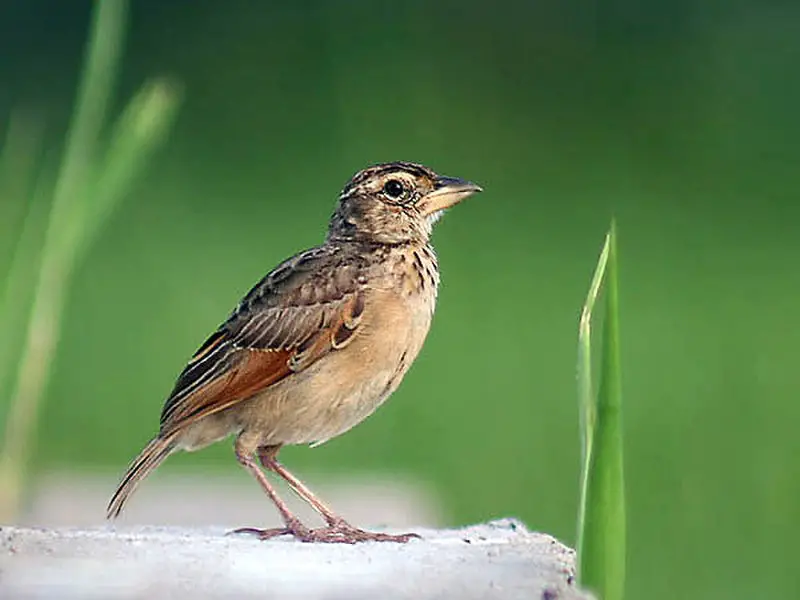
The Bengal bush lark (Mirafra assamica) is a bird belonging to the family Alaudidae, found in southern Asia. It has two races – the Bengal race “assamica” and Madras race “affinis”.
These birds have subtle differences which can only be seen when examined closely. The upper parts of their bodies are brownish-grey with black streaks while they have pale underparts and whitish throat bordered by a narrow buff stripe on each side.
They feed mainly on grass seeds, insects and spiders but also take some berries occasionally. During the breeding season these birds build cup shaped nests mostly near or at ground level among stones or bushes for laying eggs often camouflaged against predators like snakes etc.,
Their melodious songs given out from rooftops makes them popular amongst birdwatchers as well as general people alike.
Scientific classification:
| Kingdom | Animalia |
| Phylum | Chordata |
| Class | Aves |
| Order | Passeriformes |
| Family | Alaudidae |
| Genus | Mirafra |
| Species | M. assamica |
34. Finn’s Weaver
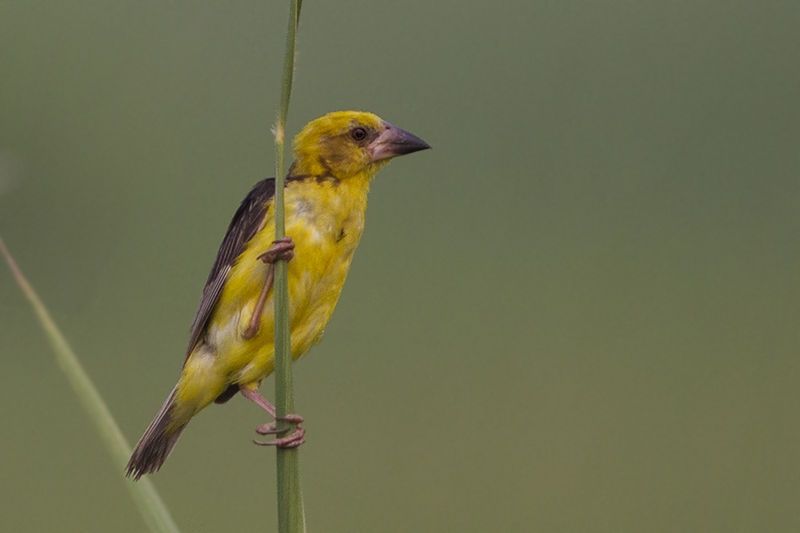
Finn’s weaver is a small bird native to the Ganges and Brahmaputra valleys in India and Nepal. It was given its binomial name by Allan Octavian Hume, who first obtained a specimen from Kaladh.
The species has two subspecies: P. megarhynchus nominate occurs in Kumaon area while salimalii is found in eastern Terai regions. This yellow-colored bird measures around 12cm with black upperparts and white underparts.
Its wings are brownish grey on top that blends into olive color at bottom side of coverts; tail feathers have same colors but shows broad edges of buff or pale yellow hues along sides which makes it distinctive among other Indian birds like orioles, drongos etc..
Their diet includes insects as well as grains making them omnivorous feeders . They build their nests using fibers collected from plants with some amount of grasses too for support structure near water bodies such as lakes, ponds or rivers making them great aquatic inhabitants.
Scientific classification:
| Kingdom | Animalia |
| Phylum | Chordata |
| Class | Aves |
| Order | Passeriformes |
| Family | Ploceidae |
| Genus | Ploceus |
| Species | P. megarhynchus |
35. Chestnut-Headed Tesia
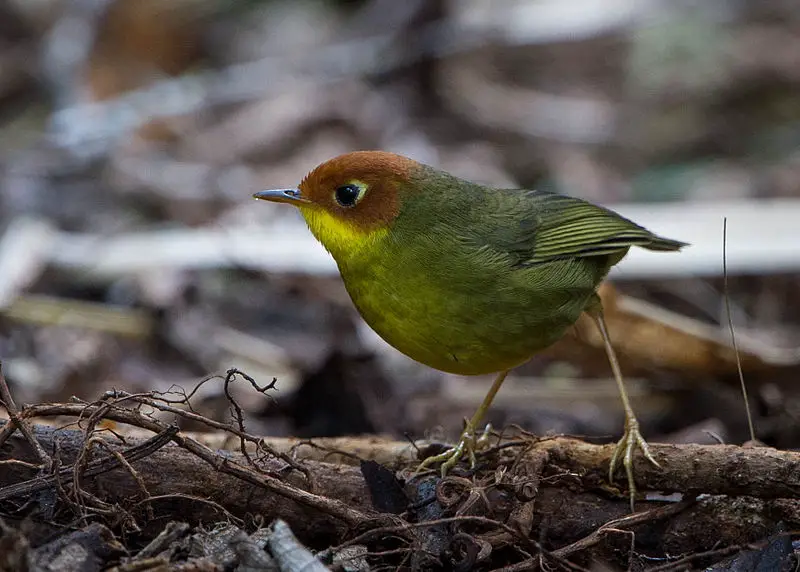
The Chestnut-headed Tesia is a small songbird that belongs to the bush warbler family. It has a distinctive chestnut-colored head and wings, which sets it apart from other members of its species.
The bird is found in countries such as Bangladesh, Bhutan, China, India, Laos Myanmar, Nepal Thailand and Vietnam. Its natural habitats are moist lowland forests and montane forest areas with high levels of moisture throughout the year.
This insectivorous bird feeds on insects like flies or beetles which make up most of its diet in addition to some seeds when available during certain seasons.
It also builds nests near trees where they can easily find food sources nearby for themselves and their young ones making them excellent tree climbers too.
They are known for their melodious songs that have been described as ‘softly chattering’.
Scientific classification:
| Kingdom | Animalia |
| Phylum | Chordata |
| Class | Aves |
| Order | Passeriformes |
| Family | Cettiidae |
| Genus | Cettia |
| Species | C. castaneocoronata |
36. Grey-Backed Shrike
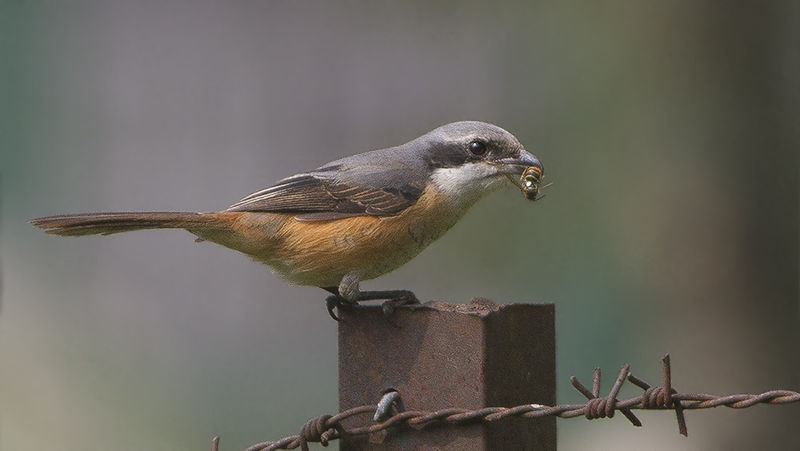
The Grey-backed shrike is an incredible bird species that can be found in South-east Asia. It was first described by Nicholas Aylward Vigors near Darjeeling, India in 1831 and belongs to the family Laniidae.
Although it is closely related to another species (L. schach) which were once treated as one, they differ morphologically and are largely sympatric despite this fact.
The grey-backed shrike has a light brown body with white spots on its wings during the breeding season along with a distinctive black cap on its head, making them easy to spot in their natural habitat of wooded areas or open grasslands.
They feed mainly on insects but have also been known to hunt small rodents too. All round they make for an interesting avian addition within their range – providing hours of observation fun.
Scientific classification:
| Kingdom | Animalia |
| Phylum | Chordata |
| Class | Aves |
| Order | Passeriformes |
| Family | Laniidae |
| Genus | Lanius |
| Species | L. tephronotus |